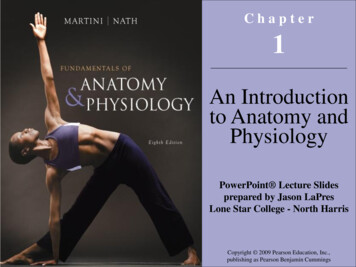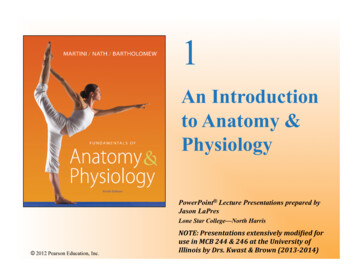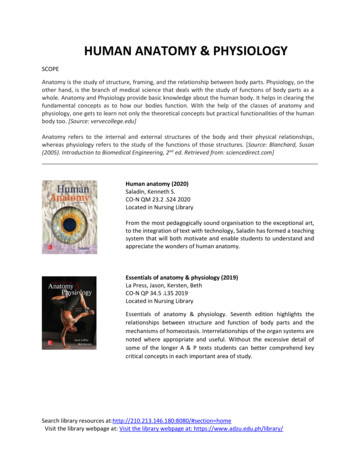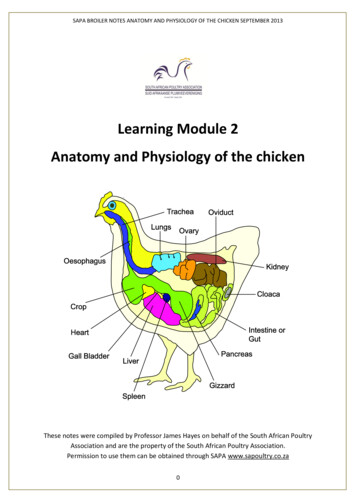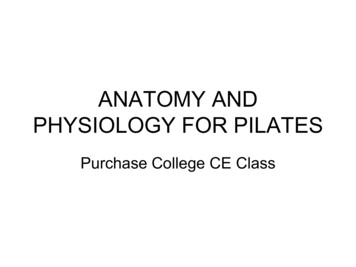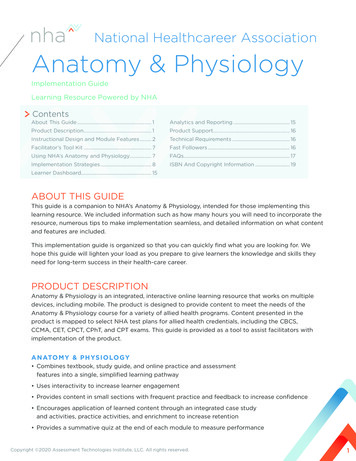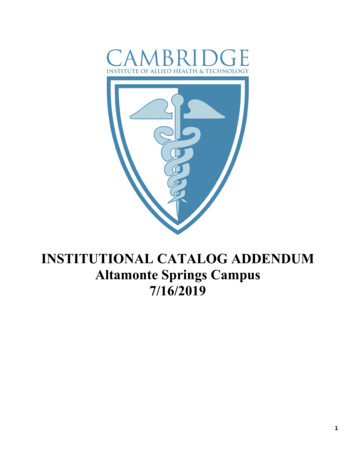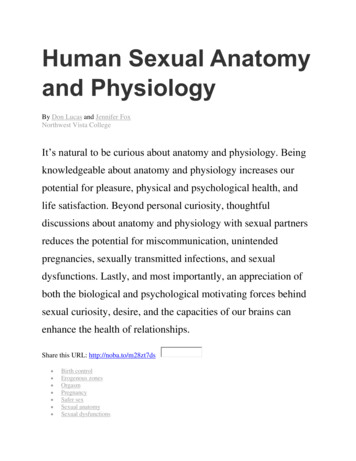
Transcription
Human Sexual Anatomyand PhysiologyBy Don Lucas and Jennifer FoxNorthwest Vista CollegeIt’s natural to be curious about anatomy and physiology. Beingknowledgeable about anatomy and physiology increases ourpotential for pleasure, physical and psychological health, andlife satisfaction. Beyond personal curiosity, thoughtfuldiscussions about anatomy and physiology with sexual partnersreduces the potential for miscommunication, unintendedpregnancies, sexually transmitted infections, and sexualdysfunctions. Lastly, and most importantly, an appreciation ofboth the biological and psychological motivating forces behindsexual curiosity, desire, and the capacities of our brains canenhance the health of relationships.Share this URL: http://noba.to/m28zt7ds Birth controlErogenous zonesOrgasmPregnancySafer sexSexual anatomySexual dysfunctions
Sexual physiologySexual response cycleSexually transmitted infectionsVulvaLearning Objectives Explain why people are curious about their own sexual anatomies and physiologies. List the sexual organs of the female and male. Describe the sexual response cycle. Distinguish between pleasure and reproduction as motives behind sexuality. Compare the central nervous system motivating sexual behaviors to the autonomicnervous system motivating sexual behaviors. Discuss the relationship between pregnancy and birth control. Analyze how sexually transmitted infections are associated with sexual behaviors. Understand the effects of sexual dysfunctions and their treatments on sexual behaviors.IntroductionMost people are curious about sex. Google processes over 3.5 billion search queries per day(Google Search Statistics)—tens of millions of which, performed under the cloak of anonymity,are about sex. What are the most frequently asked questions concerning sex on Google? Are theyabout extramarital affairs? Kinky fantasies? Sexual positions? Surprisingly, no. Usually they arepractical and straightforward, and tend to be about sexual anatomy (Stephens-Davidowitz,2015)—for example, “How big should my penis be?” and, “Is it healthy for my vagina to smelllike vinegar?” Further, Google reveals that people are much more concerned about their ownsexual anatomies than the anatomies of others; for instance, men are 170 times more likely thanwomen to pose questions about penises (Stephens-Davidowitz, 2015). The second mostfrequently asked questions about sex on Google are about sexual physiology—for example,“How can I make my boyfriend climax more quickly?” “Why is sex painful?” and, “Whatexactly is an orgasm?” These searches are clear indicators that people have a tremendous interestin very basic questions about sexual anatomy and physiology.
However, the accuracy of answers we get from friends, family, and even internet “authorities” toquestions about sex is often unreliable (Fuxman et al., 2015; Simon & Daneback, 2013). Forexample, when Buhi and colleagues (2010) examined the content of 177 sexual-health websites,they found that nearly half contained inaccurate information. How about we—the authors of thismodule—make you a promise? If you learn this material, then we promise you won’t need nearlyas many clandestine Google excursions, because this module contains unbiased andscientifically-based answers to many of the questions you likely have about sexual anatomy andphysiology.Are you ready for a new twist on “sexually-explicit language”? Even though this module is abouta fascinating topic—sex—it contains vocabulary that may be new or confusing to you. Learningthis vocabulary may require extra effort, but if you understand these terms, you will understandsex and yourself better.Masters and JohnsonAlthough people have always had sex, the scientific study of it has remained taboo untilrelatively recently. In fact, the study of sexual anatomy, physiology, and behavior wasn’tformally undertaken until the late 19th century, and only began to be taken seriously as recentlyas the 1950’s. Notably, William Masters (1915-2001) and Virginia Johnson (1925-2013) formed
a research team in 1957 that expanded studies of sexuality from merely asking people about theirsex lives to measuring people’s anatomy and physiology while they were actually having sex.Masters was a former Navy lieutenant, married father of two, and trained gynecologist with aninterest in studying prostitutes. Johnson was a former country music singer, single mother oftwo, three-time divorcee, and two-time college dropout with an interest in studying sociology.And yes, if it piques your curiosity, Masters and Johnson were lovers (when Masters was stillmarried); they eventually married each other, but later divorced. Despite their colorful privatelives they were dedicated researchers with an interest in understanding sex from a scientificperspective.Masters and Johnson used primarily plethysmography (the measuring of changes in blood- orairflow to organs) to determine sexual responses in a wide range of body parts—breasts, skin,various muscle structures, bladder, rectum, external sex organs, and lungs—as well asmeasurements of people’s pulse and blood pressure. They measured more than 10,000 orgasmsin 700 individuals (18 to 89 years of age), during sex with partners or alone. Masters andJohnson’s findings were initially published in two best-selling books: Human Sexual Response,1966, and Human Sexual Inadequacy, 1970. Their initial experimental techniques and data formthe bases of our contemporary understanding of sexual anatomy and physiology.The Anatomy of Pleasure and ReproductionSexual anatomy is typically discussed only in terms of reproduction (see e.g., King, 2015).However, reproduction is only a (small) part of what drives us sexually (Lucas & Fox, 2018).Full discussions of sexual anatomy also include the concept of pleasure. Thus, we will explorethe sexual anatomies of females (see Figures 1a and 1b) and males (see Figure 2) in terms oftheir capabilities for both reproduction and pleasure.
Figure 1a: The Female’s External Sex Organs. [Image: Open StaxCollege, https://goo.gl/Hj59kX, CC BY 3.0, https://goo.gl/Dmg4Uu]Female AnatomyMany people find female sexual anatomy curious, confusing, and mysterious. This may bebecause so much of it is internal (inside the body), or because—historically—women have beenexpected to be modest and secretive regarding their bodies.Perhaps the most visible structure of female sexual anatomy is the vulva. The primary functionsof the vulva are pleasure and protection. The vulva is composed of the female’s external sexorgans (see Figure 1a). It includes many parts:(a) the labia majora—the “large lips” enclosing and protecting the female’s internal sex organs;(b) the labia minora—the“small lips” surrounding and defining the openings of the vagina andurethra;(c) the minor and major vestibular glands (VGs).The minor VGs—also called Skene's glands (not pictured), are on the wall of the vagina and areassociated with female ejaculation, and mythologically associated with the G-Spot (Kilchevskyet al., 2012; Wickman, 2017). The major VGs—also called Bartholin's glands—are located just
to the left and right of the vagina and produce lubrication to aid in sexual intercourse. Mostfemales—especially postmenopausal females—at some time in their lives report inadequatelubrication, which, in turn, leads to discomfort or pain during sexual intercourse (Nappi &Lachowsky, 2009). Extending foreplay and using commercial water-, silicone-, or oil-basedpersonal lubricants are simple solutions to this common problem.The clitoris and vagina are considered parts of the vulva as well as internal sex organs (seeFigure 1b). They are the most talked about organs in relation to their capacities for femalepleasure (e.g., Jannini et al., 2012). Most of the clitoris, which is composed of 18 parts with anaverage overall excited length of about four inches, cannot be seen (Ginger & Yang,2011; O'Connell et al., 2005). The visible parts—the glans and prepuce—are located above theurethra and join the labia minora at its pinnacle. The clitoris is highly sensitive, composed ofmore than 8,000 sensory-nerve endings, and is associated with initiating orgasms; 90% offemales can orgasm by clitoral stimulation alone (O'Connell et al., 2005; Thompson, 2016).The vagina, also called the “birth canal,” is a muscular canal that spans from the cervix to theintroitus. It has an average overall excited length of about four and a half inches (Masters &Johnson, 1966) and has two parts: First, there is the inner two-thirds (posterior wall)—formedduring the first trimester of pregnancy. Second, there is the outer one-third of the vagina (anteriorwall). It is formed during the second trimester of pregnancy and is generally more sensitive thanthe inner portion, but dramatically less sensitive than the clitoris (Hines, 2001). Only between10% and 30% of females achieve orgasms by vaginal stimulation alone (Thompson, 2016). Ateach end of the vagina are the cervix (the lower portion of the uterus) and the introitus (thevaginal opening to the outside of the body). The vagina acts as a transport mechanism for spermcells coming in, and menstrual fluid and babies going out. A healthy vagina has a pH level ofabout four, which is acidic. When the pH level changes, often due to normal circumstances (e.g.,menstruation, using tampons, sexual intercourse), it facilitates the reproduction ofmicroorganisms that often cause vaginal odor and pain (Anderson, Klink & Cohrssen, 2004).This potential problem can be solved with over-the-counter vaginal gels or oral probiotics tomaintain normal vaginal pH levels (Tachedjiana et al., in press).
Figure 1b: The Female’sInternal Sex Organs. [Image: unknown, https://goo.gl/5GMbCr, CC BY-SA3.0, https://goo.gl/jidmcs]The primary functions of the internal sex organs of the female are to store, transport, and keepovum cells (eggs) healthy; and produce hormones (see Figure 1b). These organs include:(a) the uterus (or womb)—where human development occurs until birth;(b) the ovaries—the glands that house the ova (eggs; about two million; Faddy et al., 1992) andproduce progesterone, estrogen, and small amounts of testosterone;(c) the fallopian tubes—where fertilization is most likely to occur. These tubes allowfor ovulation (about every 28 days), which is when ova travel from the ovaries to the uterus. Iffertilization does not occur, menstruationbegins. Menstruation, also known as a “period,” is thedischarge of ova along with the lining of the uterus through the vagina, usually taking severaldays to complete.Male AnatomyThe most prominent external sex organ for the male is the penis. The penis’s main functions areinitiating orgasm, and transporting semen and urine from the body. On average, a flaccid penis isabout three and a half inches in length, whereas an erect penis is about five inches (Veale et al.,2015; Wessells, Lue & McAninch, 1996). If you want to know the length of a particular male’serect penis, you’ll have to actually see it—because there are noreliable correlations between thelength of an erect penis and (a) the length of a flaccid penis, (b) the lengths of other body parts—including feet, hands, forearms, and overall height—or (c) race and ethnicity (Shah &Christopher, 2002; Siminoski & Bain, 1993; Veale et al., 2015; Wessells, Lue & McAninch,
1996). The penis has three parts: the root, shaft, and glans. Foreskin covers the glans, or head ofthe penis, except in circumcised males. The glans penis is highly sensitive, composed of morethan 4,000 sensory-nerve endings, and associated with initiating orgasms (Halata, 1997). Lastly,it has the urethral opening that allows semen and urine to exit the body.Figure 2: The Male’sInternal and External Sex Organs. [Image: unknown, https://goo.gl/9kUDCN,CC BY-SA3.0, https://goo.gl/jidmcs]In addition to the penis, there are other male external sex organs that have two primary functions:producing hormones and sperm cells. The scrotum is the sac of skin behind and below the peniscontaining the testicles. The testicles (or testes) are the glands that produce testosterone,progesterone, small amounts of estrogen, and sperm cells.Many people are surprised to learn that males also have internal sex organs. The primaryfunctions of male internal sex organs are transporting sperm cells, keeping sperm cells healthy,and producing semen—the fluid in which sperm cells are transported. The male’s internal sexorgans include:(a) the epididymis, which is a twisted duct that matures, stores, and transports sperm cells intothe vas deferens;(b) the vas deferens—a muscular tube that transports mature sperm to the urethra, except inmales who have had a vasectomy;
(c) the seminal vesicles—glands that provide energy for sperm cells to move. This energy is inthe form of sugar (fructose) and it composes about 75% of the semen. Sperm cells only composeabout 1% of the semen (Owen & Katz, 2005);(d) the prostate gland, which provides additional fluid to the semen that nourishes the spermcells; and the Cowper's glands, which produce a fluid that lubricates the urethra and neutralizesany acidity due to urine;(e) the urethra—the tube that carries urine and semen outside of the body.Sex on the BrainFigure 3: Some of the many regions of the brain and brainstem activated during pleasureexperiences. [Image: Frank Gaillard, https://goo.gl/yCKuQ2, CC-BY-SA 3.0. Identifying marksadded]
At first glance—or touch for that matter—the clitoris and penis are the parts of our anatomiesthat seem to bring the most pleasure. However, these two organs pale in comparison to ourcentral nervous system’s capacity for pleasure. Extensive regions of the brain and brainstem areactivated when a person experiences pleasure, including: the insula, temporal cortex, limbicsystem, nucleus accumbens, basal ganglia, superior parietal cortex, dorsolateral prefrontal cortex,and cerebellum (see Figure 3, Ortigue et al., 2007). Neuroimaging techniques show that theseregions of the brain are active when patients have spontaneous orgasms involving no directstimulation of the skin (e.g., Fadul et al., 2005) and when experimental participants self-stimulateerogenous zones (e.g., Komisaruk et al., 2011). Erogenous zones are sensitive areas of skin thatare connected, via the nervous system, to the somatosensory cortex in the brain.Figure 4: Erogenous Zones Mapped on the Somatosensory Cortex.The somatosensory cortex (SC) is the part of the brain primarily responsible for processingsensory information from the skin. The more sensitive an area of your skin is (e.g., your lips), thelarger the corresponding area of the SC will be; the less sensitive an area of your skin is (e.g.,
your trunk), the smaller the corresponding area of the SC will be (see Figure 4, Penfield &Boldrey, 1937). When a sensitive area of a person’s body is touched, it is typically interpreted bythe brain in one of three ways: “That tickles!” “That hurts!” or, “That you need to do again!”Thus, the more sensitive areas of our bodies have greater potential to evoke pleasure. A study byNummenmaa and his colleagues (2016) used a unique method to test this hypothesis. TheNummenmaa research team showed experimental participants images of same- and opposite-sexbodies. They then asked the participants to color the regions of the body that, when touched, theyor members of the opposite sex would experience as sexually arousing while masturbating orhaving sex with a partner. Nummenmaa found the expected “hotspot” erogenous zones aroundthe external sex organs, breasts, and anus, but also reported areas of the skin beyond thesehotspots: “[T]actile stimulation of practically all bodily regions trigger sexual arousal .”Moreover, he concluded, “[H]aving sex with a partner ”—beyond the hotspots—“ reflects therole of touching in the maintenance of pair bonds.”Physiology and the Sexual Response CycleThe brain and other sex organs respond to sexual stimuli in a universal fashion known asthe sexual response cycle (SRC; Masters & Johnson, 1966). The SRC is composed of fourphases:1. Excitement: Activation of the sympathetic branch of the autonomic nervous systemdefines the excitement phase; heart rate and breathing accelerates, along with increasedblood flow to the penis, vaginal walls, clitoris, and nipples. Involuntary muscularmovements (myotonia), such as facial grimaces, also occur during this phase.2. Plateau: Blood flow, heart rate, and breathing intensify during the plateau phase. Duringthis phase, often referred to as “foreplay,” females experience an orgasmic platform—the outer third of the vaginal walls tightening—and males experience a release of preseminal fluid containing healthy sperm cells (Killick et al., 2011). This early release offluid makes penile withdrawal a relatively ineffective form of birth control (Aisch &Marsh, 2014). (Question: What do you call a couple who use the withdrawal method ofbirth control? Answer: Parents.)3. Orgasm: The shortest but most pleasurable phase is the orgasm phase. After reaching itsclimax, neuromuscular tension is released and the hormone oxytocin floods thebloodstream—facilitating emotional bonding. Although the rhythmic muscularcontractions of an orgasm are temporally associated with ejaculation, this association isnot necessary because orgasm and ejaculation are two separate physiological processes.4. Resolution: The body returns to a pre-aroused state in the resolution phase. Males entera refractory period of being unresponsive to sexual stimuli. The length of this perioddepends on age, frequency of recent sexual relations, level of intimacy with a partner, andnovelty. Because females do not have a refractory period, they have a greater potential—physiologically—of having multiple orgasms. Ironically, females are also more likely to“fake” having orgasms (Opperman et al., 2014).
Of interest to note, the SRC occurs regardless of the type of sexual behavior—whether thebehavior is masturbation; romantic kissing; or oral, vaginal, or anal sex (Masters & Johnson,1966). Further, a partner or environmental object is sufficient, but not necessary, for the SRC tooccur.PregnancyOne of the potential outcomes of the SRC is pregnancy—the time a female carries a developinghuman within her uterus. How does this happen?Human male, sex chromosomes highlighted [Image: National Human Genome ResearchInstitute, https://goo.gl/8UWQwa,Public Domain]The process begins during vaginal intercourse when the male ejaculates, or releases semen. Eachejaculate contains about 300 million sperm cells. These sperm compete to make their waythrough the cervix and into the uterus. Conception typically occurs within a fallopian tube whena single sperm cell comes into contact with an ovum (egg). The sperm carries either an X- or Y-
chromosome to fertilize the ovum—which, itself, usually carries an X-chromosome. Thesechromosomes, in combination with one another, are what determine a person’s sex. Thecombination of two X chromosomes produces a female zygote (fertilized ovum). Thecombination of an X and Y chromosome produces a male zygote. XX- or XY-chromosomesform your 23rd set of chromosomes (most humans have a total of 46 chromosomes) commonlyreferred to as your chromosomal sexor genetic sex.Interestingly, at least 1 in every 1,000 conceptions results in a variation of chromosomal sexbeyond the typical XX or XY sets. Some of these variations include, XXX, XXY, XYY, or evena single X (Dreger, 1998). In some cases, people may have unusual physical characteristics, suchas being taller than average, having a thick neck, or being sterile (unable to reproduce); but inmany cases, these individuals have no cognitive, physical, or sexual issues (Wisniewski et al.,2000). Almost 15 out of every 1,000 births are multiple births (twins, triplets, quadruplets, etc.).These can occur in a couple of ways. Dizygotic (fraternal) births are the result of a femalereleasing multiple ova of which more than one is fertilized by sperm. Because sperm carry eitherX or Y chromosomes, fraternal births can be any combination of sexes (e.g., two girls or a boyand a girl). They develop together in the uterus and are usually born within minutes of oneanother. Monozygotic (identical) births result from a special circumstance in which a fertilizedovum splits into multiple identical embryos and they develop simultaneously. Identical twins are,therefore, the same sex.Hours after conception, the zygote begins dividing into additional cells. It then starts travelingdown the fallopian tube until it enters the uterus as a blastocyst. The blastocyst implants itselfwithin the wall of the uterus to become an embryo (Moore, Persaud & Torchia, 2016). However,the percentage of successful implantations remains a mystery. Researchers believe the failurerate to be as high as 60% (Diedrich et al., 2007). Failed blastocysts are eliminated duringmenstruation, often without the female ever knowing conception occurred.Mothers are pregnant for three trimesters, a term that begins with their last menstrual period andends about 40 weeks later; each trimester is 13 weeks. During the first trimester, most of thebody parts of the embryo are formed, although at this stage they are not in the same proportionsas they will be at birth. The brain and head, for example, account for about half of the body atthis point. During the fifth and sixth weeks of gestation, the primitive gonads are formed. Theyeventually develop into ovaries or testes. Until the seventh week, the developing embryo has thepotential of having either male (Wolffian ducts) or female (Mullerian ducts) internal sexorgans, regardless of chromosomal sex. In fact, there is an innate tendency for all embryos tohave female internal sex organs, unless there is the presence of the SRY gene, located on the Ychromosome (Grumbach & Conte, 1998; Wizemann & Pardue, 2001). The SRY gene causesXY-embryos to develop testes (dividing cells from the medulla). The testes emit testosteronewhich stimulates the development of male internal sex organs—the Wolffian ducts transforminginto the epididymis, seminal vesicles, and vas deferens. The testes also emit a Mullerianinhibiting substance, a hormone that causes the Mullerian ducts to atrophy. If the SRY gene isnot present or active—typical for chromosomal females (XX)—then XX-embryos developovaries (dividing cells from the cortex) and the Mullerian ducts transform into female internalsex organs, including the fallopian tubes, uterus, cervix, and inner two-thirds of the vagina
(Carlson, 1986). Without a burst of testosterone from the testes, the Wolffian ducts naturallydeteriorate (Grumbach & Conte, 1998; Wizemann & Pardue, 2001).During the second trimester, expectant mothers can feel movement in their wombs. This isknown as quickening. Inside the uterus, the embryo develops fine hair all over its body(called lanugo) as well as eyelashes and eyebrows. Major organs, such as the pancreas and liver,begin fully functioning. By the 20th week of gestation, the external sex organs are fully formed,which is why “sex determination” using ultrasound during this time is more accurate than in thefirst trimester (Igbinedion & Akhigbe, 2012; Odeh, Ophir & Bornstein, 2008). Formation ofmale external sex organs (e.g., the penis and scrotum) is dependent upon high levels oftestosterone, whereas female external sex organs (e.g., the outer third of the vagina and theclitoris) form without hormonal influences (Carlson, 1986). Levels of sex hormones, such asestrogen, testosterone, and progesterone, begin affecting the brain during this trimester,impacting future emotions, behaviors, and thoughts related to gender identity and sexualorientation (Swaab, 2004). It’s important to understand that the interactions of chromosomal sex,gonadal sex, sex hormones, internal sex organs, external sex organs, and brain differentiationsduring this developmental stage are too complex to readily conform to the familiar categories ofsex, gender, and sexual orientation historically used to describe people (Herdt, 1996). Towardthe end of the second trimester—at about the 26th week—is the age of viability, when survivaloutside of the uterus has a probability of more than 90% (Rysavy et al., 2015). Interestingly,technological advances and changes in hospital care have affected the age of viability such thatviability is possible earlier in pregnancy (Rysavy et al., 2015).
Potential outcomes of the Sexual Response Cycle are pregnancy and childbirth. [Image: ErnestF, https://goo.gl/TPu7g8, CC BY-SA 3.0, https://goo.gl/jidmcs]During the third trimester, there is rapid development in the brain and rapid weight gain.Typically, by the 36th week, the fetus begins descending head-first into the uterine cavity.Getting ready for birth is not the only behavior exhibited during this last trimester. Erectileresponses in male fetuses occur during this time (Haffner, 1999; Martinson, 1994; Parrot, 1994);and Giorgi and Siccardi (1996) reported ultrasonographic observations of a fetus performingself-exploration of her external sex organs. Most babies are born vaginally (through the vagina),though in the United States one-third are by Cesarean section (through the abdomen; Molina etal., 2015). A newborn’s health is initially determined by his/her weight (normally rangingbetween 2,500 and 4,000 grams)—though birth weight significantly differs between ethnicities(Jannsen et al., 2007).
Birth ControlContraception, or birth control, reduces the probability of pregnancy resulting from sexualintercourse. There are various forms of birth control, including: hormonal, barrier, or natural. Asshown in Table 1, the effectiveness of the different forms of birth control ranges widely, from68% to 99.9% (optionsforsexualhealth.org).Table 1. Forms of Birth Control and their Effectiveness from https://www.optionsforsexualhealth.org/
Hormonal forms of birth control release synthetic estrogen or progestin, which preventsovulation and thickens cervical mucus, making it difficult for sperm to reach ova(sexandu.ca/contraception). There are a variety of ways to introduce these hormones into thebody, including: implantable rods, birth control pills, injections, transdermal patches, IUDs, andvaginal rings. For example, the vaginal ring is 92% effective, easily inserted into and taken outof the vagina by the user, and comprised of thin plastic containing a combination of hormonesthat are released during the time it is in the vagina—usually about three weeks.Barrier forms of birth control prevent sperm from entering the uterus by creating a physicalbarrier or chemical barrier toxic to sperm. There are a variety of barrier methods, including:vasectomies, tubal ligations, male and female condoms, spermicides, diaphragms, and cervicalcaps. The most popular barrier method is the condom, which is 79-85% effective. The malecondom is placed over the penis, whereas the female condom is worn inside the vagina and fitsaround the cervix. Condoms prevent bodily fluids from being exchanged and reduce skin-to-skincontact. For this reason, condoms are also used to reduce the risk of some sexually transmittedinfections (STIs). However, it is important to note that male and female condoms, or two malecondoms, should not be worn simultaneously during penetration; the friction between multiplecondoms creates microscopic tears, rendering them ineffective (Munoz, Davtyan & Brown,2014).Natural forms of birth control rely on knowledge of the menstrual cycle and awareness of thebody. They include the Fertility Awareness Method (FAM), lactational amenorrhea method, andwithdrawal. For example, the FAM is about 75% effective, and requires tracking the menstrualcycle, and avoiding sexual intercourse or using other forms of birth control during the female’sfertile window. About 30% of females’ fertile windows—the period when a female is most likelyto conceive—are between days ten and seventeen of their menstrual cycle (Wilcox, Dunson &Baird, 2000). The remaining 70% of females experience irregular and less predictable fertilewindows, reducing the efficacy of the FAM.Other forms of birth control that do not fit into the above categories include: emergencycontraceptive pills, the copper IUD, and abstinence. Emergency contraceptive pills (e.g., Plan B)delay the release of an ovum if taken prior to ovulation. Emergency contraception is a form ofbirth control typically used after unprotected sex, condom mishaps, or sexual assault. The mosteffective form of emergency contraception is the copper IUD. A medical professional inserts theIUD through the opening of the cervix and into the uterus. It is more than 99% effective and maybe left within the uterus for over 10 years. It differs from typical IUDs because it is hormone-freeand uses copper ions to create an inhospitable environment for sperm, thus significantly reducingthe chances of fertilization. Additionally, the copper ions alter the lining of the uterus, whichsignificantly reduces the probability of implantation. Lastly, abstinence—avoiding any sexualbehaviors that may lead to conception—is the only form of birth control with a 100% effectiverate.There are many factors that determine the best birth control options for any particular person.Some factors are related to personality and habits. For example, if a woman is a forgetful person,“the pill” may not be her best option, since it requires being taken daily. Other factors that
influence birth control choices include cost, age, education, religious beliefs, lifestyle, and sexualhealth.Sexually Transmitted InfectionsUnfortunately, a potential outcome of sexual activity is infection. Sexually transmittedinfections (STIs) are like other transmittable infections, except STIs are primarily transmittedthrough social sexual behaviors. Social sexual behaviors include romantic kissing and oral,vaginal, and anal sex. Additionally, STIs can be tr
Sexual physiology Sexual response cycle Sexually transmitted infections Vulva Learning Objectives Explain why people are curious about their own sexual anatomies and physiologies. List the sexual organs of the female and male. Describe the sexual response cycle. Distinguish between pleasure and reproduction as motives behind sexuality.
